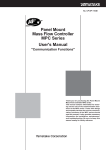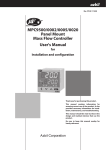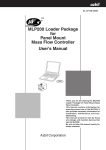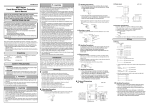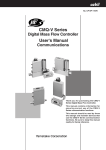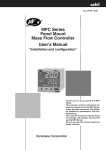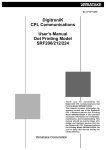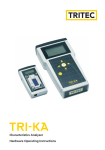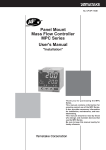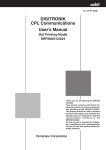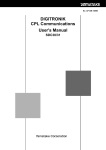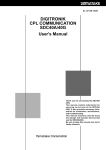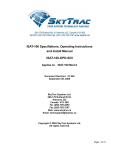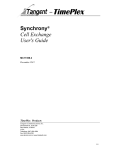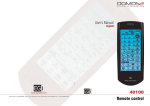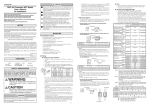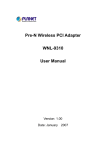Download CP-SP-1154E - Azbil Corporation
Transcript
No. CP-SP-1154E
MPC9500/0002/0005/0020
Panel Mount
Mass Flow Controller
User's Manual
for
Communication Functions
Thank you for purchasing this product.
This manual contains information
for ensuring correct use of the communication functions of the product. Those who design and maintain
devices that use the communication
functions of the product should
read this manual. It also provides
necessary information for installation, maintenance, and troubleshooting. Be sure to keep this manual nearby for handy reference.
Please read the "Terms and Conditions" from the following URL
before ordering or use:
http://www.azbil.com/products/bi/order.html
IMPORTANT
If it is necessary to change the parameters of the MPC frequently by
communication, write data at addresses of RAM. The endurance of EEPROM is
limited to 10,000 erase/write cycles.
Note, that the data in RAM is cleared, and is replaced with the data in EEPROM if
the power supply to the MPC is interrupted.
NOTICE
Be sure that the user receives this manual before the product is used.
Copying or duplicating this user’s manual in part or in whole is forbidden.
The information and specifications in this manual are subject to change
without notice.
Considerable effort has been made to ensure that this manual is free from
inaccuracies and omissions. If you should find an error or omission, please
contact the azbil Group.
In no event is Azbil Corporation liable to anyone for any indirect, special or
consequential damages as a result of using this product.
© 2004-2013 Azbil Corporation All Rights Reserved.
TM
The µF , Micro Flow TM, Micro Flow SensorTM and MPCTM are trademarks
of Azbil Corporation.
Conventions Used in This Manual
■■ To prevent injury to the operator and others, and to prevent property damage, the
following types of safety precautions are indicated:
WARNING
CAUTION
Warnings are indicated when mishandling this product might
result in death or serious injury.
Cautions are indicated when mishandling this product might result
in minor injury to the user, or physical damage to the product.
■■ In describing the product, this manual uses the icons and conventions listed below.
Use caution when handling the product.
The indicated action is prohibited.
Be sure to follow the indicated instructions.
Handling Precautions:
Handling Precautions indicate items that the user should pay attention to
when handling the MPC.
Note:
Notes indicate information that might benefit the user.
This indicates the item or page that the user is requested to refer to.
(1), (2), (3)
The numbers with the parenthesis indicate steps in a sequence or
indicate corresponding parts in an explanation.
>>
Indicates the result of an operation, details displayed on the personal
computer or other devices, or the state of the device after operation.
0FF
This indicates 7-segment indication on the setup display.
"OK" lamp
This indicates an LED lamp on the setup display.
[ENT] key
This indicates a key on the setup display.
i
Safety Precautions
WARNING
Do not use the MPC for medical instruments.
CAUTION
Before removing, mounting, or wiring the MPC, be sure to turn off the power to
the MPC and all connected devices. Failure to do so might cause electric shock.
Do not disassemble the MPC.
Doing so might cause malfunction.
Wire the MPC in compliance with the predetermined standards. Also wire the
MPC with specified power cables according to recognized installation methods.
Failure to do so might cause malfunction.
Use the MPC within the operating ranges (temperature, humidity, voltage, vibration, shock, mounting direction, atmosphere, etc.) recommended in the specifications.
Failure to do so might cause malfunction.
Make sure that wire scraps, chips or water do not enter inside the case of the
MPC.
Failure to do so might cause faulty operation or malfunction.
ii
The Role of This Manual
A total of four different manuals are available for the Panel Mount Mass Flow Controller
MPC. Read them as necessary for your specific requirements. If a manual you require is not
available, contact the azbil Group or its dealer.
MPC9500/0002/0005/0020 Panel Mount Mass Flow Controller
User's Manual
Manual No. CP-UM-5317E
This manual is supplied with the product. Personnel in charge of
design and/or manufacture of a system using this unit must thoroughly read this manual. This manual describes the safety precautions, installation, wiring and primary specifications. For further
information about operation, refer to other manuals, "Installation &
Configurations".
MPC9500/0002/0005/0020
Panel Mount Mass Flow Controller User's Manual for Installation
and Configurations
Manual No. CP-SP-1153E
This manual describes the hardware and all functions of this unit.
Personnel in charge of design, manufacture, operation, and/or
maintenance of a system using this unit must thoroughly read this
manual. This manual also describes the installation, wiring, all functions and settings of this unit, operating procedures, troubleshooting, and detailed specifications.
MPC9500/0002/0005/0020 Panel Mount Mass Flow Controller
User's Manual for Communication Functions
Manual No. CP-SP-1154E
This manual.
Those using the "communication functions" of the MPC should
read this manual.
This manual describes an outline of communications, wiring,
communication procedures, a list of this manual describes communication data, how to remedy trouble, and communication
specifications.
MLP200A Loader Package for Panel Mount Mass Flow Controller
User's Manual No. CP-UM-5355E
This manual is included with the MLP200A100 loader package.
This manual describes the software used on a personal computer
to configure the MPC. Personnel in charge of design or configuration of a system using the MPC should read this manual thoroughly. The manual also describes the installation of the software
on a personal computer, the operation of the personal computer,
various functions, and setup procedures.
iii
Organization of This User's Manual
This manual is organized as follows:
Chapter 1.INTRODUCTION
This chapter describes communication outline of the MPC.
Chapter 2.WIRING
Chapter 3.SETTING
This chapter describes RS-485 wiring methods to make a communication link between the MPC and other instruments.
This chapter describes MPC communication settings.
Chapter 4.COMMUNICATION PROCEDURE
This chapter describes communication procedures, message configuration, data read/write and signal timing operations.
Chapter 5.COMMUNICATION DATA TABLE
This chapter provides various data address tables for communications on the MPC.
Chapter 6.COMMUNICATION PROGRAM FOR MASTER STATION
This chapter gives precautions for programming and an example
of a communication program for the MPC.
Chapter 7.TROUBLESHOOTING
This chapter describes checkpoints to diagnose failures in MPC
communications.
Chapter 8.SPECIFICATIONS
This chapter lists communication specifications for the MPC.
Appendix
The appendix provides code tables.
iv
Contents
Conventions Used in This Manual
Safety Precautions
The Role of This Manual
Organization of This User's Manual
Chapter 1.INTRODUCTION. . . . . . . . . . . . . . . . . . . . . . . . . . . . . . . . . . . . . . . . . . . 1-1
Chapter 2.WIRING. . . . . . . . . . . . . . . . . . . . . . . . . . . . . . . . . . . . . . . . . . . . . . . . . . . . 2-1
Chapter 3.SETTING
■■Setting method. . . . . . . . . . . . . . . . . . . . . . . . . . . . . . . . . . . . . . . . . . . 3-1
■■Setting items of communication. . . . . . . . . . . . . . . . . . . . . . . . . . . 3-1
Chapter 4.COMMUNICATION PROCEDURE
4 - 1 Outline of Communication Procedure and Messages . . . . . . . . . . 4-1
■■Communication procedure. . . . . . . . . . . . . . . . . . . . . . . . . . . . . . . . 4-1
■■Message configuration. . . . . . . . . . . . . . . . . . . . . . . . . . . . . . . . . . . . 4-1
■■Examples. . . . . . . . . . . . . . . . . . . . . . . . . . . . . . . . . . . . . . . . . . . . . . . . . 4-2
■■Data address concept . . . . . . . . . . . . . . . . . . . . . . . . . . . . . . . . . . . . . 4-2
4 - 2 Data Link Layer. . . . . . . . . . . . . . . . . . . . . . . . . . . . . . . . . . . . . . . . . . . . . 4-3
■■Description. . . . . . . . . . . . . . . . . . . . . . . . . . . . . . . . . . . . . . . . . . . . . . . 4-3
4 - 3 Application Layer. . . . . . . . . . . . . . . . . . . . . . . . . . . . . . . . . . . . . . . . . . . 4-6
■■Outline. . . . . . . . . . . . . . . . . . . . . . . . . . . . . . . . . . . . . . . . . . . . . . . . . . . 4-6
4 - 4 Data Read. . . . . . . . . . . . . . . . . . . . . . . . . . . . . . . . . . . . . . . . . . . . . . . . . . 4-7
■■Description of read instruction . . . . . . . . . . . . . . . . . . . . . . . . . . . . 4-7
■■Read response. . . . . . . . . . . . . . . . . . . . . . . . . . . . . . . . . . . . . . . . . . . . 4-8
■■Decimal numeric expression (numeric data) . . . . . . . . . . . . . . . . 4-9
4 - 5 Data Write. . . . . . . . . . . . . . . . . . . . . . . . . . . . . . . . . . . . . . . . . . . . . . . . . 4-10
■■Description of write instruction. . . . . . . . . . . . . . . . . . . . . . . . . . . 4-10
■■Write response . . . . . . . . . . . . . . . . . . . . . . . . . . . . . . . . . . . . . . . . . . 4-11
4 - 6 Termination Code Table . . . . . . . . . . . . . . . . . . . . . . . . . . . . . . . . . . . . 4-12
■■Normal and warning termination . . . . . . . . . . . . . . . . . . . . . . . . . 4-12
■■Error termination. . . . . . . . . . . . . . . . . . . . . . . . . . . . . . . . . . . . . . . . 4-12
4 - 7 Timing Specifications . . . . . . . . . . . . . . . . . . . . . . . . . . . . . . . . . . . . . . 4-13
■■ Timing specifications for instruction and response messages. . . . . 4-13
■■RS-485 driver control timing specifications. . . . . . . . . . . . . . . . 4-13
■■Other precautions . . . . . . . . . . . . . . . . . . . . . . . . . . . . . . . . . . . . . . . 4-14
v
Chapter 5.COMMUNICATION DATA TABLE
5 - 1 Basic Communication Data Processing . . . . . . . . . . . . . . . . . . . . . . .
■■Communication data types and formats. . . . . . . . . . . . . . . . . . . .
■■Communication data storage memory . . . . . . . . . . . . . . . . . . . . .
■■Data address . . . . . . . . . . . . . . . . . . . . . . . . . . . . . . . . . . . . . . . . . . . . .
■■Number of data read / write . . . . . . . . . . . . . . . . . . . . . . . . . . . . . . .
■■Data unit and decimal point position. . . . . . . . . . . . . . . . . . . . . . .
5 - 2 Communication Data Table. . . . . . . . . . . . . . . . . . . . . . . . . . . . . . . . . .
■■Device related data . . . . . . . . . . . . . . . . . . . . . . . . . . . . . . . . . . . . . . .
■■Operating status related data. . . . . . . . . . . . . . . . . . . . . . . . . . . . . .
■■Instantaneous flowrate related data . . . . . . . . . . . . . . . . . . . . . . .
■■Integrated flowrate related data. . . . . . . . . . . . . . . . . . . . . . . . . . .
■■Function setup related data . . . . . . . . . . . . . . . . . . . . . . . . . . . . . . .
■■Parameter setup related data. . . . . . . . . . . . . . . . . . . . . . . . . . . . . .
5-1
5-1
5-1
5-2
5-2
5-2
5-3
5-3
5-4
5-5
5-5
5-6
5-9
Chapter 6.COMMUNICATION PROGRAM FOR MASTER STATION
6 - 1 Precautions for Programming . . . . . . . . . . . . . . . . . . . . . . . . . . . . . . .
6 - 2 Examples of Communication Program. . . . . . . . . . . . . . . . . . . . . . . .
■■Prior to running the sample program. . . . . . . . . . . . . . . . . . . . . . .
■■Running the sample program. . . . . . . . . . . . . . . . . . . . . . . . . . . . . .
■■Data read/write sample program . . . . . . . . . . . . . . . . . . . . . . . . . .
6-1
6-2
6-2
6-2
6-3
Chapter 7.TROUBLESHOOTING
■■Check items in case communication is disabled. . . . . . . . . . . . . 7-1
Chapter 8.SPECIFICATIONS
■■RS-485 specifications . . . . . . . . . . . . . . . . . . . . . . . . . . . . . . . . . . . . . 8-1
Appendix
■■Code table. . . . . . . . . . . . . . . . . . . . . . . . . . . . . . . . . . . . . . .Appendix -1
■■Connection with CMC10L001A000. . . . . . . . . . . . . . . . Appendix -2
vi
Chapter 1. INTRODUCTION
The MPC (hereafter referred to as the slave station) is able to communicate with a personal computer or PLC as a host computer (hereafter referred to as the master station) regarding setup
values and data through an RS-232C/RS-485 converter.
In the RS-485 system, up to 31 units can be connected with one master station. The station address is used to identify slave station for communication.
To write a setup value or read a monitor from master station to slave station, you must write a
communication program for this purpose.
• When the following procedure is completed during communication, various data for the controller can be read or written:
(1) The master station transmits a request message to the slave
station.
(2) The master station receives a response message from the slave
station.
• The commands from master station to slave station are classified
into two types; read and write.
• The type of read/write data can be selected by data address.
Host station (a device, etc.)
RS-232C port
(D-SUB 9 pin)
RS-232C
DC IN
SD
PWR/RD
RS-232C
RS-232C / RS-485
converter *
(CMC10L001A000)
11
12
RS-485
13
14
15
RS-485(3-wire system)
Slave station (MPC, etc.)
Max. 31 units
* The
CMC10L001A000 communication controller is an RS-232C/RS-485
(3-wires system) converter available from Azbil Corporation.
1-1
Chapter 2. WIRING
CAUTION
Before removing, mounting, or wiring the MPC, be sure to turn off the power to the
MPC and all connected devices. Failure to do so might cause electric shock.
Do not disassemble the MPC.
Doing so might cause malfunction.
Wire the MPC in compliance with the predetermined standards. Also wire the MPC with
specified power cables according to recognized installation methods.
Failure to do so might cause malfunction.
Use the MPC within the operating ranges (temperature, humidity, voltage, vibration,
shock, mounting direction, atmosphere, etc.) recommended in the specifiations.
Failure to do so might cause malfunction.
Handling Precautions
• For wiring information other than that of RS-485, refer to the following manuals.
•
MPC 9500/0002/0005/0020 Panel Mount Mass Flow Controller User's
Manual,CP-UM-5317E
•
MPC9500/0002/0005/0020 Panel Mount Mass Flow Controller User's
Manual for Installation and Configuration,
CP-SP-1153E
•
MLP200 Loader Package for Panel Mount Mass Flow Controller User's
ManualCP-UM-5355E
2-1
Chapter 2. WIRING
A sample RS-485 connection is shown below.
Slave station (MPC, etc.)
Terminating
resistor
7
8
9
7
8
9
DA
DB
SG
DA
DB
SG
Shield
FG
Host station (a device, etc.)
DA
DB
SG
FG
Shield
FG
Slave station (MPC, etc.)
DA
7
Terminating
resistor
8
DB
SG
9
Connect terminating resistors of 150 Ω ±5 %, 1/2 W or more to the
both ends of the communication path.
Ground the shield to the FG at one end of the shield.
Make sure that the shield is not grounded at both ends of the shield.
On 3-wire system, Azbil Corporation’s CMC10L001A000 controller
can be used as a converter of the master station.
Handling Precautions
• Be sure to connect SG terminals each other.
Failure to do so might cause unstable communications.
2-2
Chapter 3. SETTING
Before starting communication, set the communication condition and station address of the slave
station to meet that of the master station.
■■ Setting method
Operate the following procedure to set the communication functions:
(1) Put
the integrated display mode by pressing the [DISP] key.
>> The "L" lamp lights.
(2) K
eep pressing the [<] key for about 3 s.
>> T
he "0.r G" displays on the upper display and the mode
transit the parameter settings mode.
(3) Keep pressing the [<] key for about 3 s again.
>> The item No."C-0 1" appears on the upper display and the
mode transit the function setting mode.
(4) Select a target setting item by pressing either [ ] key or [ ] key.
(5) P
ress the [ENT] key.
>> The current setting value blinks on the lower display.
(6) S elect a target setting by pressing either [ ] key or [ ] key.
(7) P
ress the [ENT] key at the target setting.
>> The setting value stores in memory and renews.
(8) W
hen wanting to set another setting items, return to (4) operation, and wanting no more, go to (9) operation.
(9) P
ress the [DISP] key
>> The mode returns to the normal display of instantaneous PV
indication.
Handling Precautions
• If any key is not pressed for 1 min after the function settings
mode, the mode returns to the normal display of instantaneous
PV indication.
• When pressing the [DISP] key without pressing the [ENT] key
after (6) operation, the setting is not renewed but remained as
the previous value.
• When setting a station address "0", the communication function
does not work.
■■ Setting items of communication
Display
Description
C-30
Station address
C-3 1
Transmission
speed selection
C-32
Communications
condition
Contents
0: Communications function
disabled
1 to 127: Communications address
0: 38400 bps
1: 19200 bps
2: 9600 bps
3: 4800 bps
4: 2400 bps
0: 8 bits data, even parity, 1 stop bit
1: 8 bits data, no parity, 2 stop bits
Initial
Remarks
value
0
The communications function does
not work at "0". Set a different address among the slave stations.
1
0
3-1
Chapter 4. COMMUNICATION PROCEDURE
4 - 1
Outline of Communication Procedure and Messages
This chapter describes the outline of communication procedure and the concept behind message
configuration.
■■ Communication procedure
The following is a simple breakdown of the communication procedure:
(1) The master station transmits an instruction message to a slave station to specify a station for communication.
(2) T
he slave station processes the instruction message, and executes
read and write operations.
(3) T
he slave station transmits a response message according to the
contents of processing.
(4) The
master station receives the response message and executes
processing.
■■ Message configuration
A message consists of two layers as shown below. Both the instruction message from a master station and the response message from a
slave station take this form.
Data link layer
• This layer contains the basic information required for communication.
• It also contains message destination and check information.
Application layer
• This layer is where data read and write operations are executed.
• The content of this layer varies according to the purpose of the
operation.
The figure below shows the individual layers.
•
•
Application layer
A total of 31 units
Data link layer
Instruction message from master station
Response message from slave station
Slave station (MPC, etc.)
Host station (a device, etc.)
Application layer
Data link layer
The driver of the data link layer knows:
• Destination (station address)
• Load check sheet (checksum)
The load (data) of the application layer
changes every time according to the
purpose of the operation.
4-1
Chapter 4. COMMUNICATION PROCEDURE
■■ Examples
Messages have the following structure:
●● Read instruction
Instruction message
STX
0
1
0
0
X
R
S
,
Data link layer
1
0
0
1
W
,
2
ETX
Application layer
9
A
CR
LF
Data link layer
Response message
STX
0
1
0
0
X
0
0
Data link layer
,
0
,
4
2
ETX
9
4
CR
LF
Data link layer
Application layer
●● Write instruction
Instruction message
STX
0
1
0
0
X
W
S
,
Data link layer
1
0
0
1
W
,
5
8
ETX
Application layer
5
A
CR
LF
Data link layer
Response message
STX
0
1
0
Data link layer
0
X
0
0
ETX
Application layer
8
2
CR
LF
Data link layer
The following sections describe in detail the data link layer and application layer:
■■ Data address concept
The MPC uses "data addresses" to read and write data. Data addresses
allow data to be written and read to and from a corresponding address for the data.
Data A
Data B
Data C
:
1001W
1002W
1003W
:
5-2 Communication Data Table (page 5-3)
4-2
Chapter 4. COMMUNICATION PROCEDURE
4 - 2
Data Link Layer
■■ Description
• The data link layer contains eight types of basic message transmission information.
• The instruction message and response message have the same
structure in the data link layer.
ETX
Checksum
STX
Station address
Subaddress
Device ID code
CR
LF
02H 30H 41H 30H 30H 58H 52H 53H 2CH 31H 30H 30H 31H 57H 2CH 32H 03H 38H 41H 0DH 0AH
STX
0
A
0
0
X
R
S
,
Data link layer
1
0
0
1
Application layer
W
,
2
ETX
8
A
CR
LF
Data link layer
The following describes each function of the data link layer:
●● STX (Start of TeXt)
: Indicates the beginning of a message.
✦ Role
●● Station address
✧ Description: • Fixed at 02H.
• W
hen the instrument receives an STX, it is identified as the first character of a new instruction
message regardless of location with a message.
:Specifies the destination station, and allows communication with the specified station.
✦ Role
✧ Description: • If
"0" is set as the station address, the communication function is disabled. So, to enable communication be sure to set an address value of "1" or more.
• Two
hexadecimal characters. For details, see the
example.
❐ Example
:When the station address of the destination is "10":
(1) 10 (decimal) = 0AH (hexadecimal)
(2) Converting into character codes:
0 = 30H, A = 41H
(3)"0A" (30H, 41H) is used as the station address.
Note
•
Chapter 3 "SETTING"
Handling Precautions
• Note that the function of the station address differs entirely from
that of the data address of the application layer.
4-3
Chapter 4. COMMUNICATION PROCEDURE
●● Subaddress
✧ Description:The subaddress is meaningless on the MPC.
Be sure to set a subaddress of "00" (30H, 30H) that
has the same format as the station address.
●● Device ID code
✧ Description:Only character codes "X" (58H) or "x" (78H) can be
set on the MPC.
●● ETX (End of TeXt)
✦ Role
: Indicates the end of the application layer.
✧ Description: Fixed at 03H.
●● Checksum
✦ Role
:A value to be used to check whether or not a message has been corrupted by an error (such as noise)
during communication.
✧ Description: • Two hexadecimal characters.
• This function operates as follows:
(1) Add one byte each to the character codes of the
message from STX to ETX.
(2) Calculate the two's complement of the result of
this addition.
(3) Convert the result into character codes.
:The instruction message on the page 4-3 is used in
the following example:
(1) Add one byte each to the character codes from
STX to ETX. The lower-order one byte of the
calculation result is 76H.
(2) The result of two's complement addition is 8AH.
(3) Converted into character codes and use as the
checksum value. The result is "8A", (38H) and
(41H).
See the station address example (on the page 4-3)
for information on character code conversion.
❐ Example
Handling Precautions
• Do not omit the checksum in the instruction message .
4-4
Chapter 4. COMMUNICATION PROCEDURE
●● CR and LF (Carriage Return / Line Feed)
: Indicates the end of a message.
✦ Role
✧ Description: • "CR" is (0DH), and "LF" is (0AH).
• Be sure to use CR and LF in pair.
Handling Precautions
• If any of the following errors occur in the data link layer, the MPC
does not respond:
• The
communication conditions for both stations do not match
(different transmission speeds or the occurrence of a parity
error).
•
STX, ETX, CR and LF are not placed at the right positions.
• The
device ID code is neither "X" nor "x".
• The
station address, subaddress or checksum is not two character codes.
• The
calculation of the checksum does not agree with that of
the message.
•
Non-specified characters are included in the message.
• The
destination station address differs from the station address
for the receiving station.
• The
station address set to "00".
• The contents of the data link layer of the response message are
same as the instruction message except for the checksum function.
• Use capital letters "A" to "F" in the hexadecimal numerics for the
station address and checksum.
4-5
Chapter 4. COMMUNICATION PROCEDURE
4 - 3
Application Layer
■■ Outline
• The application layer contains instructions, data, number of data
and termination code.
• In the application layer, the instruction message and response message have a different structure.
• There are two types of instruction messages: read instructions and
write instructions. Each of these instruction messages have their
own responses.
• A termination code indicates how an instruction message has been
processed.
Item
(1) Commands
Description
"RS" (decimal format continuous address data read)
"WS" (decimal format continuous address data write)
"RD" (hexadecimal format continuous address data read)
"WD" (hexadecimal format continuous address data write)
(2) Data delimiters
RS or WS command: “,” (comma)
RD or WD command: None
(3) Word addresses
RS or WS command: Numeric value in decimal notation and "W," such as
"1001W"
RD or WD command: 4-digit numeric value in hexadecimal notation,
such as "03E9"
(4)-1 Read count
RS command: Numeric value in decimal notation, such as "1"
RD command: 4-digit numeric value in hexadecimal notation, such as
"0001"
(4)-2 Write count
WS command: Numeric value in decimal notation, such as "123"
WD command: 4-digit numeric value in hexadecimal notation, such as
"007B"
4-6
Chapter 4. COMMUNICATION PROCEDURE
4 - 4
Data Read
■■ Description of read instruction
•T
his instruction permits the contents of continuous data addresses
starting from the specified start data address to be read in one message.
• The application layer of a read instruction consists of the following
three types of data:
Read command
Start data address
Read count
02H 30H 31H 30H 30H 58H 52H 53H 2CH 31H 30H 30H 31H 57H 2CH 32H 03H 39H 41H 0DH 0AH
STX
0
1
0
0
X
R
Data link layer
S
,
1
0
0
1
W
,
2
ETX
Application layer
9
A
CR
LF
Data link layer
❐ Example :The above example shows that two-data items are
read from 1001 W as one message.
• Individual data items are delimited by a comma "," (character code 2CH).
• An capital letter code is used for each numeric or character in the
application layer.
• A decimal number is used for each numeric.
• Additional "0"s or spaces cannot be added to each data item.
❐ Example :The underlined portion of "RS,01001W,2" is not allowed.
The underlined portions of "RS, 1001W,02" are not
allowed.
●● Read command (RS)
✦ Role
: A read command
✧ Description: Two "RS" (52H, 53H) characters
●● Start data address
✦ Role
: Specifies the start data address.
✧ Description: • 5-2 "Communication Data Table"(page 5-3)
• B
e sure to append the numeric representing the
data address with "W" (57H).
●● Number of read data
✦ Role
:Specifies how many data items are read continuously, starting with the specified data address.
✧ Description:There is a limit for the number of data to read in one
message.
Number of data read/write
(page 5-2).
4-7
Chapter 4. COMMUNICATION PROCEDURE
■■ Read response
When the message in the data link layer is correct, a response message is sent back according to the contents of the instruction message.
All data in the application layer is expressed in decimal character
code.
●● Termination code
:A numeric which specifies how the instruction message has been processed by the instrument.
Different values are set according to the processing
result.
✧ Description:The response message must include a termination
code. The termination codes are classified as follows:
✦ Role
Termination code
Normal
* The termination
code is a
2-digit decimal.
Alarm
Error
●● Normal response
:Sends back the read data.
• Data items are delimited with a comma "," (character code 2CH).
• Each data range and number of digits depend on
the read data.
• Digit without a decimal point is used for read data.
✦ Role
❐ Example:
"20.0" is converted to "200" when entered.
A normal response. (when two data items are read properly.)
Termination code (00 = normal)
Read data
02H 30H 31H 30H 30H 58H 30H 30H 2CH 31H 32H 33H 2CH 38H 37H 30H 03H 46H 35H 0DH 0AH
STX
0
1
0
0
X
0
0
,
1
Data link layer
2
3
,
8
7
0
ETX
Application layer
F
5
CR
LF
Data link layer
●● Alarm response
A warning response. (❈❈ indicates the warning code numeric.)
Termination code (❈❈ = warning)
Read data
4-8
02H 30H 31H 30H 30H 58H ❈H
❈H 2CH 30H 2CH 38H 37H 30H 03H ??H ??H 0DH 0AH
STX
❈
0
1
0
Data link layer
0
X
❈
,
0
,
8
Application layer
7
0
ETX
?
?
CR
Data link layer
LF
Chapter 4. COMMUNICATION PROCEDURE
●● Error response
Indicates that there is an abnormality in an instruction message,
which contains no data and cannot be normally read.
A warning response. (❈❈ indicates the warning code numeric.)
Termination code
(❈❈ = error)
02H 30H 31H 30H 30H 58H ❈H
STX
0
1
0
Data link layer
0
X
❈
❈H 03H ??H ??H 0DH 0AH
❈
ETX
Application layer
??
??
CR
LF
Data link layer
■■ Decimal numeric expression (numeric data)
Handling Precautions
• All numeric, read count, and write count and read data in the
data address follow the rules given below.
(1)When a numeric is negative, prefix the numeric with a minus
sign "-" (2DH).
❐ Example: "-123" (2DH, 31H, 32H, 33H)
(2)When a numeric is "0", use one "0".
❐ Example: "0" (30H)
"00" (30H, 30H) is not allowed.
(3)When a numeric is positive, never prefix the numeric with a
plus sign "+".
❐ Example: "+123" (2BH, 31H, 32H, 33H) is not allowed.
(4)Never add additional "0"s or spaces before a numeric.
❐ Example: "0123" (30H, 31H, 32H, 33H) is not allowed.
" 123" (20H, 31H, 32H, 33H) is not allowed.
4-9
Chapter 4. COMMUNICATION PROCEDURE
4 - 5
Data Write
■■ Description of write instruction
• This instruction permits the contents of continuous data addresses
starting with the specified start data address to be simultaneously
written in one message.
• The application layer of a write instruction consists of the following
three types of data:
Write command
Write data (1st data item)
Write data (2nd data item)
Start data address
02H 30H 31H 30H 30H 58H 57H 53H 2CH 31H 30H 30H 31H 57H 2CH 32H 2CH 36H 35H
STX
0
1
0
0
X
Data link layer
W
S
,
1
0
0
1
W
,
2
,
6
5
Application layer
03H 46H 45H 0DH 0AH
ETX
F
E
CR
LF
Data link layer
❐ Example :The above example shows that "2" and "65" are written at address 1001W and 1002W in one message.
•Individual data items are delimited with a comma "," (character code 2CH).
• The number of write data does not need to specify.
• A capital letter code is used for each numeric or character in the
application layer.
• A decimal number is used for each numeric.
• Additional "0"s (30H) or spaces cannot be added to each data item.
❐ Example :The underlined portion of "WS,01001W,1" is not allowed.
The underlined portions of "WS, 1001W,01" are not allowed.
●● Write command (WS)
✦ Role
: A write command
✧ Description: Two "WS" (57H, 53H) characters
●● Start data address
●● Write data
✦ Role
: Specifies the start data address.
5-2 "Communication Data Table" (page 5-3)
• e sure to append the numeric representing the
• B
data address with "W" (57H).
:Data to be written to continuous addresses starting
with the specified data address.
✧ Description: • The range of a numeric to be written differs according to each data address.
• Individual data are delimited by a comma "," (2CH).
• The data address at which the corresponding data
is written, is incremented by 1 sequentially, starting
with the start data address (see the example above).
• The number of data item which can be written in
Number of data
one message is limited.
read / write (page 5-2) for details.
✦ Role
4-10
Chapter 4. COMMUNICATION PROCEDURE
■■ Write response
:When the message in the data link layer is correct,
only the termination code is sent back.
✧ Description: The termination codes are classified as follows:
✦ Role
Termination code
Normal
* The termination
code is a
2-digit decimal.
Alarm
Error
●● Normal response
:Returns how the write instruction message has been
processed.
Only a normal termination code or warning termination code is returned.
✦ Role
Termination code (00 = normal)
02H 30H 31H 30H 30H 58H 30H 30H 03H 38H 32H 0DH 0AH
STX
0
1
0
0
Data link layer
X
0
0
ETX
Application layer
8
2
CR
LF
Data link layer
:Normal response (when all data items are correctly
written)
❐ Example
●● Alarm response
Termination code (❈❈ = warning)
02H 30H 31H 30H 30H 58H ??H ??H 03H ??H ??H 0DH 0AH
STX
0
1
0
0
Data link layer
X
❈
❈
ETX
Application layer
?
?
CR
LF
Data link layer
A warning response (❈❈ indicates the warning code numeric.)
●● Error response
: Only the abnormal termination code is returned.
:An abnormal response (❈❈ indicates an abnormal
response.)
✦ Role
❐ Example
Termination code (❈❈ = error)
02H 30H 31H 30H 30H 58H ❈H
STX
0
1
0
Data link layer
0
X
❈
❈H 03H ??H ??H 0DH 0AH
❈
ETX
Application layer
?
?
CR
LF
Data link layer
4-11
Chapter 4. COMMUNICATION PROCEDURE
4 - 6
Termination Code Table
■■ Normal and warning termination
Termination
code
Type
Contents and action
00
Normal Normal end
21
Alarm
Wrote data in the address that could not be set in the communication due to the setup allotment by external switching inputs.
Continue the process without writing any in the concerned address.
23
Alarm
The Read is stopped due to access to the address outside the scope.
The Write is stopped due to access to the address outside the scope.
All messages are processed except the address outside the scope.
■■ Error termination
4-12
Termination
code
Type
40
Error
"W" has not been set at the address.
All messages are scrapped.
41
Error
"WS", or "RS" has not been set.
All messages are scrapped.
43
Error
ETX(03H) is not set in the correct position.
"," is not set after the address.
All messages are scrapped.
46
Error
The address is erroneous.
All messages are scrapped.
47
Error
There is an error in the written numeric.
All messages are scrapped.
48
Error
There is an error in the written numeric.
Write has been executed, except for the error address.
99
Error
An undefined command or other message error.
All messages are scrapped.
Contents and action
Chapter 4. COMMUNICATION PROCEDURE
4 - 7
Timing Specifications
■■ Timing specifications for instruction and response messages
The following precautions regarding the transmission timing of
instruction messages from the master station and response messages
from the slave station should be observed:
●● Response time-out
The maximum response time from the end of the instruction message transmission by the master station until when the master station
receives a response message from the slave station is 2 seconds ((1) in
figure). So, the response time-out should be set to 2 seconds.
Generally, when a response time-out occurs, the instruction message
is resent.
For details,
Chapter 6 "COMMUNICATION PROGRAM FOR
MASTER STATION."
●● Transmission start time
(1)
Transmission
line
Instruction
message
(2)
Response
message
Instruction
message
Response
message
(1)
End of master station transmission - Transmission start time of slave station = 2 s max.
(For the master station, the response time-out after the end of instruction message transmission should
e set to 2 s.)
(2)
End of slave station transmission - Transmission start time of master station = 10 ms min.
(For the master station, stand by for 10 ms or more from the end of response message receipt to the
start time of next transmission.)
■■ RS-485 driver control timing specifications
When the transmission/reception on the RS-485 3-wire system is
directly controlled by the master station, care should be paid to the
following timing:
Master station
Driver control
Transmission line
Slave station
Driver control
(1)
(4)
(enable)
(disable)
Effective
data
(instruction message)
(disable)
Effective
data
(response message)
(enable)
(2)
End of master station
transmission
(3)
End of slave station
transmission
(1) End of master station transmission - Driver disable time = 500 s max.
(2) End of slave station reception - Driver enable time = 15 ms min.
(3) End of slave station transmission - Driver disable time = 10 ms max.
(4) End of master station reception - Driver enable time = 10 ms min.
4-13
Chapter 4. COMMUNICATION PROCEDURE
■■ Other precautions
• The time required for the master station to finish the transmittal of
instruction message and for the slave station to start the transmittal
of response message becomes longer if the number of data to write
and read increases.
When the faster response time is required by the slave station, make
sure to keep the number of data to read / write at the minimum in
one message.
• When the number of data is one data to read / write in one message,
the time required for the master station to finish the instruction
message and for the slave station to transmit the response message
is about 30 ms.
4-14
Chapter 5. COMMUNICATION DATA TABLE
5 - 1
Basic Communication Data Processing
■■ Communication data types and formats
●● Types of communication data
The communications data are categorized as follow:
• Device related data
• Operating status related data
• Instantaneous flowrate related data
• Integrated flow related data
• Function setup related data
• Parameter setup related data
●● Format of communication data
Communication data is classified into the following formats:
• Numeric data:Data indicating a numeric value (PV, SP, etc.).
• Bit data:Data where each bit is significant (alarms, etc.).
Bit data must be composed by transmission and
decomposed by reception.
IMPORTANT
If it is necessary to change the parameters of the MPC frequently by communication,
write data at addresses of RAM. The endurance of EEPROM is limited to 10,000 erase/
write cycles.
Note, that the data in RAM is cleared, and is replaced with the data in EEPROM if the
power supply to the MPC is interrupted.
■■ Communication data storage memory
●● Memory type
The communication data are stored in the following two types of
memory:
• RAM:Stored data is cleared when the power is turned OFF.
However data can be written to this memory infinitely.
• EEPROM:Stored data is retained even when the power is turned
OFF, whereas data erase/write cycles are limited to a
total of 10,000 times owing to device characteristics.
●● Communication object memory
In communication, it is necessary to read/write data from/into the
abovementioned two types of memory according to the purpose and
use. There is a difference between the object memories as follows:
• RAM:Data is read/written from/into RAM only. If the
power supply is turned off after writing data into
RAM, and then it is turned on again, the data in
EEPROM is copied on RAM, so the data in RAM
becomes the same as in EEPROM.
• EEPROM:Data are written in both RAM and EEPROM.
5-1
Chapter 5. COMMUNICATION DATA TABLE
■■ Data address
The data addresses are allocated as shown in the table below.
RAM
Communication data
EEPROM
Offset value
Address
Offset value
Address
Device related data
1000
1001 to 1199
4000
4001 to 4199
Operating status related data
1200
1201 to 1399
4200
4201 to 4399
Instantaneous flowrate related data
1400
1401 to 1599
4400
4401 to 4599
Integrated flowrate related data
1600
1601 to 1799
4600
4601 to 4799
Function setup related data
2000
2001 to 2199
5000
5001 to 5199
Parameter setup related data
2200
2201 to 2399
5200
5201 to 5399
■■ Number of data read / write
The number of data which can be continuously read/written by once
communication is as shown in the tabble below.
Read
Write
RAM
1 to 10 words
1 to 10 words
EEPROM
1 to 10 words
1 to 10 words
■■ Data unit and decimal point position
Read/write data is not appended with a decimal point.
The unit and decimal point position is determined for each data item.
For details on the data unit and decimal point position, see the Panel
Mount Mass Flow Controller User's Manual.
5-2
Chapter 5. COMMUNICATION DATA TABLE
5 - 2
Communication Data Table
The enabling conditions for the address and R/W (Read/Write) of each data are specified in the
following table:
The meaning of symbols in the R/W column:
❍ Possible
✕ Impossible
■■ Device related data
Display
Data range
RAM
Address R
EEPROM
W Address R
W
Remarks
Gas type
0: User Setting
1: Air/Nitrogen
3: Argon
4: Carbon dioxide (CO2)
1001
❍ ✕
4001
✕ ✕ Change in gas type is possible
with the function setup
(Address 5018).
Full- scale flow
Depended on each
flowrate range
1002
❍ ✕
4002
✕ ✕ The value with excluded
decimal point.
Decimal point
display position
of instantaneous
flowrate
0: No decimal point
1: XXXX.
2: XXX.X
3: XX.XX
4: X.XXX
1003
❍ ✕
4003
✕ ✕
Decimal point
display position
of integrated
flowrate
0: No decimal point
1: XXXXXXXX.
2: XXXXXXX.X
3: XXXXXX.XX
4: XXXXX.XXX
1004
❍ ✕
4004
✕ ✕
5-3
Chapter 5. COMMUNICATION DATA TABLE
■■ Operating status related data
Display
Data range
RAM
Address R
EEPROM
W Address R
W
Remarks
Alarm status bit
Refer to *1
1201
❍ ✕
4201
✕ ✕ Status is shown in decimal
numbers
Event status bit
Refer to *2
1202
❍ ✕
4202
✕ ✕ Status is shown in decimal
numbers
Control status bit
Refer to *3
1203
❍ ✕
4203
✕ ✕ Status is shown in decimal
numbers
Operation mode
0: Valve full close
1: Valve control
2: Valve full open
1204
❍ ❍
4204
❍ ❍ Can not write when the valve
is in full close or full open
resulted forcibly by external
inputs.
Instantaneous SP
No. in use
0: SP-0
1: SP-1
2: SP-2
3: SP-3
1205
❍ ❍
4205
❍ ❍ Can not write when SP No.
switching is being selected by
external inputs.
The number larger than the
one being selected with SP
No.(Address 5004) of the function setup can not be written.
Instantaneous
SP value in use
(0 to 100 % FS)
L/min(standard)
1206
❍ ✕
4206
Instantaneous
PV value
(0 to 100 % FS)
L/min(standard)
1207
❍ ✕
4207
✕ ✕ The value with excluded
decimal point of flow (L/min
standard) multiplied by the
✕ ✕ percent in the full-scale flow
bracket.
Valve drive
current output
0.0 to 100.0 %
1208
❍ ✕
4208
✕ ✕ The value with excluded
decimal point.
*1 Alarm status bit configuration (Address 1201)
Bit No.
0
1
2
3
4
5
6
7
8
*2 Event status bit configuration (Address 1202)
5-4
Bit No.
0
1
2
3
4
5
6
7
0: Nomal 1: Error
Description
Flowrate deviation low limit alarm
Flowrate deviation high limit alarm
Undefined (normally 0)
Undefined (normally 0)
Sensor error
Input / output adjustment data error
Sensor calibration data error
User setup data error
Valve overheat prevention limit is operated
Description
Event output 1 status
Event output 2 status
Undefined (normally 0)
External switch input 1 status
External switch input 2 status
Undefined (normally 0)
Undefined (normally 0)
Undefined (normally 0)
0: OFF 1: ON
Chapter 5. COMMUNICATION DATA TABLE
*3 Control status bit configuration (Address 1203)
Bit No.
0
1
2
3
4
5
6
7
0: OFF 1: ON
Description
OK lamp (Instantaneous PV control status)
0: Light-out 1: Lighting (Instantaneous PV OK)
Slow start operation
0: Normal operation 1: Slow start operation
Digital setting / Analog setting
0: Digital setting 1: Analog setting
Integrated count status
0: Integrated PV < Integrated SP
1: Integrated PV ≥ Integrated SP
Undefined (normally 0)
Undefined (normally 0)
Undefined (normally 0)
Undefined (normally 0)
■■ Instantaneous flowrate related data
RAM
EEPROM
Display
Data range
Digital instantaneous
flowrate SP-0
(0 to 100 % FS)
L/min (standard)
1401
❍ ❍
4401
Digital instantaneous
flowrate SP-1
(0 to 100 % FS)
L/min (standard)
1402
❍ ❍
4402
Digital instantaneous
flowrate SP-2
(0 to 100 % FS)
L/min (standard)
1403
❍ ❍
4403
❍ ❍ The value with excluded
decimal point of flow (L/min
❍ ❍ (standard)) multiplied by the
percent in the full-scale flow
bracket
❍ ❍
Digital instantaneous
flowrate SP-3
(0 to 100 % FS)
L/min (standard)
1404
❍ ❍
4404
❍ ❍
Address R
W Address R
W
Remarks
■■ Integrated flowrate related data
RAM
EEPROM
Display
Data range
Integrated SP setup
lower 4 digits
0 to 9999
1601
❍ ❍
4601
❍ ❍ Same as RAM address 2218
and 5218 in parameter set up
Integrated SP setup
upper 4 digits
0 to 9999
1602
❍ ❍
4602
❍ ❍ Same as RAM address 2219
and 5219 in parameter set up
Integrated PV setup
lower 4 digits
0 to 9999
1603
❍ ❍
4603
Integrated PV setup
upper 4 digits
0 to 9999
1604
❍ ❍
4604
❍ ❍ When resetting the integrated
value,make sure to write “0”
❍ ❍ for the both lower and upper
digits.
Address R
W Address R
W
Remarks
5-5
Chapter 5. COMMUNICATION DATA TABLE
■■ Function setup related data
Display
Setting range
RAM
Address R
EEPROM
W Address R
W
2001
❍ ❍
5001
❍ ❍
0: Disabled selection by
Operation
key operation
mode selection
(selection by key 1: Enabled selection by key
operation
operation)
2002
❍ ❍
5002
❍ ❍
Instantaneous
flowrate setup
method (instantaneous SP setup
method selection)
0: D
igital setup (set by key operation or communications)
1: A
nalog setup (set by external analog input voltage)
2003
❍ ✕
5003
❍ ✕ *1
Number of
instantaneous
flowrate setups
selection
(number of
instantaneous
SPs selection)
0: Number of SPs = 1
(SP-0 only)
1: Number of SPs = 2
(SP-0, SP-1)
2: Number of SPs = 3
(SP-0 to SP-2)
3: Number of SPs = 4
(SP-0 to SP-3)
2004
❍ ❍
5004
❍ ❍
Instantaneous
0: 0 to 5 V input
flowrate analog in- 1: 1 to 5 V input
put voltage range
selection (SP analog input voltage
range selection)
2005
❍ ✕
5005
❍ ✕ *1
Instantaneous
0: 0 to 5 V output
flowrate analog
1: 1 to 5 V output
output voltage range
selection (PV analog
output voltage range
selection)
2006
❍ ✕
5006
❍ ✕ *1
Event 1 output
0: Not used (normally OFF) 2007
type assignment 1: ON at alarm occurred
2: Integrated pulse output
Event 2 output
3: ON at instantaneous PV OK 2008
type assignment 4: ON during control mode
5: ON during fully open mode
6:ON during control or fully
open mode
7: ON during fully closed mode
8: Instantaneous high limit event
9: Instantaneous low limit event 1
10:Instantaneous low limit event 2
11:Integrated flowrate event
-1 to -11:Reversed output 1
to 11 above.
(ON at normal times,
OFF at event occurrence)
❍ ❍
5007
❍ ❍
❍ ❍
5008
❍ ❍
Key lock
5-6
0: Key lock disabled
1: Settings
other than
instantaneous SP and
integrated SP are keylocked
2: A
ll settings key-locked
Remarks
Chapter 5. COMMUNICATION DATA TABLE
Display
Setting range
RAM
Address R
EEPROM
W Address R
W
2009
❍ ✕
5009
❍ ✕ *1
External contact 1 0: Not used
2010
input function
1: Reset integration
assignment
2: Stop integration count
operation
3: Switching of instantaneous
SP No.
4: Switching of instantaneous
flowrate setup method
5: Operating mode forced
fully closed
External contact 2 6: Operating mode forced
2011
input function
fully open
assignment
7: Switching of slow start
operation
8: S witching of operation mode
(Control at contact ON,
forced fully closed at contact
OFF)
❍ ❍
5010
❍ ❍
❍ ❍
5011
❍ ❍
Undefined
Undefined
0
0
2012
❍ ✕
5012
❍ ✕ *1
Automatic valve 0: Function disabled
shut-off function 1: Function enabled
at integrated
flowrate event
occurrence
2013
❍ ❍
5013
❍ ❍
Switching of
integrated reset
function at start
of control
0: Function disabled
1: Function enabled
2014
❍ ❍
5014
❍ ❍
Flowrate alarm
setup type
0: Function disabled
1: Only high limit alarm
use
2: Only low limit alarm
used
3: High/low limit alarm
used
2015
❍ ❍
5015
❍ ❍
Operation selection at alarm
occurrence
0: Control continued
(alarm ignored)
1: Forced fully closed
2: Forced fully open
2016
❍ ❍
5016
❍ ❍
Slow start setup
0: Slow start disabled
1 to 8: Slow start enabled
(equivalent to about 1
to 6 seconds settling
time)
2017
❍ ❍
5017
❍ ❍
2018
❍ ❍
5018
❍ ❍
Gas type selection 0: Conversion factor for
each gas type set by the
user
1: Air/Nitrogen
3: Argon
4: Carbon dioxide (CO2)
Remarks
5-7
Chapter 5. COMMUNICATION DATA TABLE
Display
Setting range
Flowrate display
unit selection
0: 20 °C, 101.325 kPa (1 atm)
1: 0 °C, 101.325 kPa (1 atm)
2: 25 °C, 101.325 kPa (1 atm)
3: 35 °C, 101.325 kPa (1 atm)
RAM
Address R
EEPROM
W Address R
W
2019
❍ ❍
5019
❍ ❍
Inlet pressure setup 0: 0 to 0.1 MPa
1: 0.05 to 0.15 MPa
2: 0.15 to 0.25 MPa
3: 0.25 to 0.35 MPa
4: 0.35 to 0.45 MPa
5: 0.45 to 0.5 MPa
2020
❍ ❍
5020
❍ ❍
Instantaneous flow- 0: Function disabled
rate direct setting
1: Function enabled
functional change
2021
❍ ❍
5021
❍ ❍
Undefined
2022
❍ ✕
5022
❍ ✕ *1
PV filter (Average) 0: No filtering
2023
1: Moving average of 2 samples
2: Moving average of 4 samples
3: Moving average of 8 samples
❍ ❍
5023
❍ ❍
Undefined
0
2024
❍ ✕
5024
❍ ✕ *1
Undefined
0
2025
❍ ✕
5025
❍ ✕ *1
Undefined
0
2026
❍ ✕
5026
❍ ✕ *1
Undefined
0
2027
❍ ✕
5027
❍ ✕ *1
Analog optional
scaling function
0: Function disabled
1: Function enabled
2028
❍ ✕
5028
❍ ✕ *1
PV forced zero
function
0: Function disabled
1: Function enabled
2029
❍ ❍
5029
❍ ❍
Station address
setting
0: Communication functions disabled
1 to 127: Station address
2030
❍ ✕
5030
❍ ✕ *1
Transmission
speed selection
0: 38400 bps
1: 19200 bps
2: 9600 bps
3: 4800 bps
4: 2400 bps
2031
❍ ✕
5031
❍ ✕ *1
Communication
conditions selection
0: 8 data bits, even parity, 1
stop bit
1: 8 data bits, no parity, 2
stop bits
2032
❍ ✕
5032
❍ ✕ *1
Undefined
0
2033
❍ ✕
5033
❍ ✕ *1
Undefined
0
2034
❍ ✕
5034
❍ ✕ *1
SP limit function
0: Function disabled
1: Only high limit used
2: Only low limit used
3: High and low limits used
2035
❍ ❍
5035
❍ ❍ *2
0
Remarks
*1 Though
a normal termination code is returned after sending the write instruction message, the data cannot
be written.
*2 Neither read nor write is possible for products shipped in December 2006 or earlier.
5-8
Chapter 5. COMMUNICATION DATA TABLE
■■ Parameter setup related data
Display
Setting range
RAM
Address R
EEPROM
W Address R
Remarks
W
Instantaneous flowrate
O.K judgment range
(0.5 to 100 % FS)
L/min (standard)
2201
❍ ❍
5201
Instantaneous flowrate
O.K judgment hysteresis
(0.5 to 100 % FS)
L/min (standard)
2202
❍ ❍
5202
Instantaneous flowrate
deviation high limit alarm
(0.5 to 100 % FS)
L/min (standard)
2203
❍ ❍
5203
Instantaneous flowrate deviation high limit alarm hysteresis
(0.5 to 100 % FS)
L/min (standard)
2204
❍ ❍
5204
Instantaneous flowrate
deviation low limit alarm
(0.5 to 100 % FS)
L/min (standard)
2205
❍ ❍
5205
Instantaneous flowrate deviation
low limit alarm hysteresis
(0.5 to 100 % FS)
L/min (standard)
2206
❍ ❍
5206
❍ ❍
Instantaneous flowrate deviation alarm judgment delay time
1.0 to 999.9 s
2207
❍ ❍
5207
❍ ❍ *2
Event 1 output delay time
0.0 to 999.9 s
2208
❍ ❍
5208
Event 2 output delay time
0.0 to 999.9 s
2209
❍ ❍
5209
❍ ❍ Even if the delay time is
set, it is disabled during
❍ ❍ selection of integration
pulse output. *2
User setup conversion
factor (C.F.)
0.100 to 9.999
2210
❍ ❍
5210
❍ ❍ Under the gas type
selection (Address 5018)
of the function setup,
the setup value is only
effective when the ” User
setup” is selected. *2
0
2211
❍ ✕
5211
❍ ✕ *1
Undefined
❍ ❍ The result becomes the flowrate
(L/min(standard))
❍ ❍
obtained by multiplying the full❍ ❍ scale flowrate by
the percentage in
❍ ❍ parentheses.
(The setting range
vary according to
❍ ❍ the model.)
*2
0
2212
❍ ✕
5212
❍ ✕ *1
Event 1 output
high-low limit flowrate setup
(0 to 100 % FS)
L/min (standard)
2213
❍ ❍
5213
❍ ❍ *2
Event 2 output
high-low limit flowrate setup
(0 to 100 % FS)
L/min (standard)
2214
❍ ❍
5214
❍ ❍ *2
Undefined
0
2215
❍
*1
5215
❍
*1
Undefined
0
2216
❍
*1
5216
❍
*1
(10 to 100 % FS)
L/min (standard)
2217
❍
*1
5217
❍
*1, *2
Integrated SP setup
lower 4 digits
0 to 9999
2218
❍ ❍
5218
❍ ❍ Same as address
1601 and 4601. *2
Integrated SP setup
upper 4 digits
0 to 9999
2219
❍ ❍
5219
❍ ❍ Same as address
1602 and 4602.
Undefined
Analog option scaling
function
0.0 to 999.9 s
2220
❍ ❍
5220
❍ ❍ *2
SP high limit flow rate
(100 % FS) L/min
2221
❍ ❍
5221
SP low limit flow rate
(0 % FS) L/min
2222
❍ ❍
5222
❍ ❍ The data range
varies depending
❍ ❍ on the model. *3
PV forced zero function delay time
*1 Though
a normal termination code is returned after sending the write instruction message, the data cannot
be written.
*2 All data is handled without the decimal point.
*3 Neither read nor write is possible for products shipped in December 2006 or earlier.
5-9
Chapter 6. COMMUNICATION PROGRAM FOR MASTER STATION
6 - 1
Precautions for Programming
Pay attention to the following points when making communications programs:
• The longest response time on the device is 2 s. For this reason, set the response monitor time
to 2 s.
• Resend the same message if there is no response within 2 s. Set a communications error to
occur if there is no response even after 2 retries.
• Be sure to make the above resends to guard against the case when the message cannot be send
correctly due to the influence of noise, for example, during communications.
Note
• When the master station resends the message, alternatively use
the device ID codes "X" and "x." This is convenient as you can tell
whether or not the received message is the previously received
message.
6-1
Chapter 6. COMMUNICATION PROGRAM FOR MASTER STATION
6 - 2
Examples of Communication Program
The program is written in Borland's C++Builder5.0 or Borland C++Compiler5.5 for Windows95/98/NT/2000.
This program is given here as a reference when the user makes a program, and does not assure
all the operations.
You can download Borland C++Compiler5.5 from Borland Home Page.
■■ Prior to running the sample program
Make sure to check the settings for communications type, station address, transmission speed and data format of the instrument.
■■ Running the sample program
This program is used for reading and writing data. When the program is executed, the application layers of the instruction message
and response message communicated are indicated.
command:RS,1000W,2
result:00,0,0
command:WS,1000W,2
result:00
Sample indication of execution results
●● Communication settings
Call open() and initialize the RS-232C serial port.
●● Command execution
Set a desired character string in "command" and call AppCPL().
6-2
Chapter 6. COMMUNICATION PROGRAM FOR MASTER STATION
■■ Data read/write sample program
Handling Precautions
• Azbil Corporation assumes no responsiblity with regard to any trouble caused
by using this program.
6-3
Chapter 6. COMMUNICATION PROGRAM FOR MASTER STATION
6-4
Chapter 6. COMMUNICATION PROGRAM FOR MASTER STATION
6-5
Chapter 6. COMMUNICATION PROGRAM FOR MASTER STATION
6-6
Chapter 6. COMMUNICATION PROGRAM FOR MASTER STATION
6-7
Chapter 7. TROUBLESHOOTING
■■ Check items in case communication is disabled
(1) Check the power supply.
(2) Check the wiring.
(3) Check
if the communication conditions for the MPC meet those
for the host computer.
If any one of the following setting items is different between both
stations, communication is disabled:
The underlined items mean that they can be set on the MPC side.
Transmission speed : 2400, 4800, 9600, 19200, 38400 bps
: 7, 8 bits
Data length
Parity: No parity, odd parity, even parity
Stop bit
: 1 stop bit, 2 stop bits
(4)Check if the destination address of the command frame transmitted from the host computer meets the address set to the
MPC.
The address of the MPC set to "0" for factory setting.
Even when the destination address of the command frame is set
to "00" (30H, 30H), the MPC does not respond to such a message.
(5)Are those multi-dropped MPC being operated themselves with
different station address setups?
(6)Check that the communication timing is correct.
ing Specifications.
4-7 Tim-
(7)Use the capital letter character codes for all the character codes
other than the device ID code ("X" or "x" in this instrument).
7-1
Chapter 8. SPECIFICATIONS
■■ RS-485 specifications
Item
Remarks
Transmission mode
Balanced
Transmission line
3-wire system
Transmission speed (bps)
2400, 4800, 9600, 19200, 38400
Transmission distance
500 m max.
(300 m when connected with the MA500DIM and CMC410.)
Communications flow
Half duplex
Synchronization
Start-stop synchronization
Data format
8 data bits, 1 stop bit, even parity
8 data bits, 2 stop bits, no parity
Error detection
Parity check, checksum
Station address
0 to 127
(Communication function is inhibited when set to "0".)
Network type
1: N
(31 units or less)
Other items
Conforms to RS-485 interface specifications.
8-1
Appendix
■■ Code table
UPPER
2
3
4
5
6
7
0
SPACE
0
@
P
`
p
1
!
1
A
Q
a
q
LOWER
0
1
2
STX
"
2
B
R
b
r
3
ETX
#
3
C
S
c
s
4
$
4
D
T
d
t
5
%
5
E
U
e
u
6
&
6
F
V
f
v
7
'
7
G
W
g
w
8
(
8
H
X
h
x
9
)
9
I
Y
i
y
*
:
J
Z
j
z
B
+
;
K
[
k
{
C
,
<
L
\
l
|
-
=
M
]
m
}
E
.
>
N
^
n
~
F
/
?
O
_
o
^
A
D
LF
CR
The shaded part (
) is not used for this communication
system. (The codes to be used change every instrument.)
Appendix-1
Appendix
■■ Connection with CMC10L001A000
The following diagram shows an example of wiring using a straight
cable for a host computer in the terminal mode:
Slave station (MPC, etc.)
Terminating
resistor
DA
DB
SG
Shielded
cable
RD
SD
DA
MOD.
2
2
3
3
FG
DB
TER.
MOD.
SG
TER.
RS
CS
DR
SG
7
7
8
8
6
6
5
5
ER
4
4
CD
1
1
Shielded
cable
Slave station (MPC, etc.)
DA
DB
SG
Host station
(a device, etc.)
FG
Shielded
cable
CMC10L001A000
Slave station (MPC, etc.)
DA
Terminating
resistor
DB
SG
FG
Connect terminating resistors of 150 Ω ±5 %, 1/2 W or more to the
both ends of the communication path.
Ground the shield to the FG at one end of the shield. Make sure that
the shield is not grounded ato both ends of the shield.
Handling Precautions
• Be sure to connect SG terminals each other.
Failure to do so might cause unstable communications.
Appendix-2
Appendix
Connect the master station SD to the slave station RD, and the master
station RD to the slave station SD.
To execute this connection, set the MODE switch provided in the
CMC10L001A000 as shown in the following table in accordance with
the host computer side RS-232C connector pin arrangement (modem/terminal) and the type of cable (cross/straight) used:
RS-232C
TERMINAL
TERMINAL
MODEM
MODEM
Cable type
Straight
Cross
Straight
Cross
MODE switch
MODEM
TERMINAL
TERMINAL
MODEM
●● RS-232C cable
Straight:An RS-232C cable with a D-SUB (9-pin) connector at
each end where pins with the same number are mutually
connected (for example, pin 2 to pin 2, and pin 3 to pin 3)
CD
RD
SD
ER
SG
DR
RS
CS
1
2
3
4
5
6
7
8
1
2
3
4
5
6
7
8
CD
RD
SD
ER
SG
DR
RS
CS
Cross:An RS-232C cable with a D-SUB (9-pin) connector at
each end where different number pins are connected (for
example, pin 2 to pin 3, and pin 3 to pin 2)
RD
SD
RS
CS
DR
ER
CD
SG
2
3
7
8
6
4
1
5
2
3
7
8
6
4
1
5
RD
SD
RS
CS
DR
ER
CD
SG
D-Sub (25-pin) – D-Sub (9-pin) conversion cable:
An RS-232C cable for conversion between D-Sub
(25-pin) and D-Sub (9-pin)
FG
SD
RD
RS
CS
DR
ER
CD
SG
1
2
3
4
5
6
20
8
7
3
2
7
8
6
4
1
5
SD
RD
RS
CS
DR
ER
CD
SG
Appendix-3
Revision History of CP-SP-1154E
Printed
Edn.
Apr. 2004
Apr. 2012
July 2013
1
2
3
Revised pages
Description
Company name changed.
The manual name was changed.
Inside front cover Trademark information was added.
iv, vii, 1-1, 2-2,
MPC Series → MPC
4-2, 4-4, 4-5, 5-1
7-1, Appendix-2
“The Role of This Manual” section was changed.
iii
1-1, Appendix-2 “CMC10L” was changed to “CMC10L001A000.”
Appendix-3
1-1
Terms in the figure were changed.
2-1, 5-2
“MPC Series was changed to “Panel Mount Mass Flow Controller.”
Diagram was replaced with a table.
4-6
4-9
"Decimal numeric expression (numeric data)" section was replaced with
Handling Precautions.
5-5
The “Integrated flowrate related data”table was changed.
5-8
“1 atmosphere was changed to “1 atm.”
5-8, 5-9
Items were added to the table. *2 was added.
Specifications are subject to change without notice.
1-12-2 Kawana, Fujisawa
Kanagawa 251-8522 Japan
URL: http://www.azbil.com
(09)
1st edition: Apr. 2004 ( E )
3rd edition: July 2013 ( V )
























































